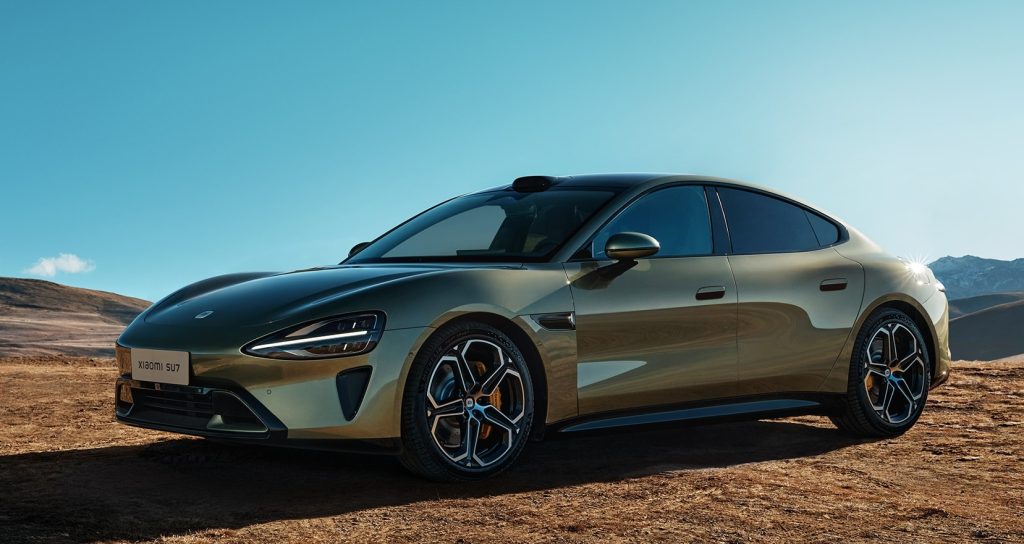Xiaomi’s Ambitious Plan to Conquer the EV Market
Xiaomi, the world’s third-largest smartphone maker, has unveiled its first electric car, the SU7, and announced its vision to become a top automaker. Learn how Xiaomi plans to leverage its existing strengths and advantages to dominate the EV market.
Meet Lei Jun, the founder and CEO of Xiaomi
Lei Jun is not your typical billionaire. He is humble, frugal, and passionate about technology. He started Xiaomi in 2010 with a simple goal: to make high-quality smartphones that are affordable for everyone. In just over a decade, Xiaomi has grown into one of the most successful smartphone companies in the world, with over 300 million users and a market value of over $100 billion.
But Lei Jun is not satisfied with just making phones. He has a bigger dream: to make electric cars that can rival Tesla and other leading brands. In this article, we will explore how Xiaomi plans to enter and dominate the electric vehicle market with its first car, the SU7, and its innovative operating system, HyperOS.

Xiaomi’s First Electric Car: The SU7
Xiaomi unveiled its first electric car, the SU7, at the inaugural Stride launch event in Beijing on December 28, 2023. The SU7 is a sleek and futuristic sedan that features a LiDAR sensor on the roof, a large touchscreen on the dashboard, and a minimalist interior design.
The SU7 offers two powertrain options: a rear-wheel drive with a 220kW (295 hp) motor and an all-wheel drive with a 275kW (368 hp) + 220kW motor setup. The SU7 can reach a top speed of 265 kph (165 mph) and has a range of 600 km (373 miles) on a single charge.
The SU7 is expected to go on sale in 2024, with a starting price of around $40,000. The SU7 is designed to compete with Tesla’s Model 3, which is the best-selling electric car in the world. However, Xiaomi claims that its car has several advantages over Tesla’s, such as a longer range, a faster speed, a more advanced sensor, and a more user-friendly operating system.
Xiaomi’s Vision: To Become a Top Five Automaker
Xiaomi announced that it will invest $10 billion over the next 10 years to develop its electric car business, with Lei Jun leading the new venture as the chairman. Xiaomi aims to produce 900,000 electric cars by 2027 and become one of the world’s top five automakers.
Xiaomi believes that it has the competitive edge over other EV makers, thanks to its strong brand recognition, loyal customer base, and extensive ecosystem of smart devices and services. Xiaomi also plans to leverage its expertise in software, hardware, and internet to create a seamless and smart driving experience for its users.
Xiaomi’s vision is to transform the car from a mere transportation tool to a smart device that can connect with users’ homes, phones, and online platforms. Xiaomi wants to offer its customers a holistic and smart lifestyle, where they can enjoy the convenience, entertainment, and security of Xiaomi’s products and services.
Xiaomi’s Operating System: HyperOS
HyperOS is an operating system that connects users’ homes, cars, and mobile devices, creating a unified and personalized ecosystem. HyperOS allows users to control their Xiaomi products, such as smartphones, smart TVs, smart speakers, and smart home appliances, from their car or vice versa.
HyperOS also enables users to access various online services, such as music, video, navigation, social media, and e-commerce, from their car or vice versa. HyperOS is designed to enhance the safety, convenience, and entertainment of driving, as well as to provide users with customized and intelligent solutions.
For example, HyperOS can automatically adjust the car’s temperature, lighting, and music according to the user’s preferences and mood. HyperOS can also monitor the user’s health and alert them if they are feeling tired or stressed. HyperOS can also recommend the best routes, parking spots, and nearby attractions based on the user’s needs and interests.
HyperOS is compatible with Android and iOS devices, as well as with other smart devices that support the Internet of Things (IoT) protocol. HyperOS is also open to third-party developers, who can create apps and services for the platform. HyperOS aims to create a rich and diverse ecosystem that can cater to different users and scenarios.

Xiaomi’s Challenges: Competition and Regulation
Xiaomi faces fierce competition from other EV makers, both domestic and foreign, such as Tesla, Nio, Li Auto, BYD, Geely, Volkswagen, and Toyota. These companies have already established their presence and reputation in the EV market, and have loyal customers and fans. Xiaomi will have to prove that its car can match or surpass the quality, performance, and innovation of its rivals.
Xiaomi also faces regulatory hurdles and uncertainties, such as the approval of its sales license, the availability of charging infrastructure, and the compliance with environmental and safety standards. Xiaomi will have to navigate the complex and dynamic legal and policy landscape of different countries and regions, and adapt to the changing consumer preferences and expectations.
Xiaomi needs to overcome the challenges of entering a new and complex industry, such as the development of core technologies, the establishment of a supply chain, and the management of quality and cost. Xiaomi will have to invest heavily in research and development, production, and marketing, and balance the trade-offs between speed and scale, efficiency and innovation, and profitability and growth.
Xiaomi’s Opportunities: Growth and Innovation
Xiaomi has the opportunity to tap into the huge and growing market for electric cars, especially in China, which is the world’s largest EV market and accounts for more than half of the global EV sales. China has been promoting the adoption of electric cars as part of its efforts to reduce carbon emissions and achieve its climate goals. China also has a large and diverse consumer base, with different needs, preferences, and budgets.
Xiaomi has the opportunity to innovate and differentiate its products and services, by integrating its smartphone and internet capabilities, as well as by offering new features and functions, such as autonomous driving, cloud computing, and artificial intelligence. Xiaomi can also leverage its existing ecosystem of smart devices and services, and create synergies and cross-selling opportunities with its car.
Xiaomi has the opportunity to create value and loyalty for its customers, by providing them with a holistic and smart lifestyle, as well as by offering them affordable and high-quality products. Xiaomi can also leverage its fan community and social media platforms, and engage with its customers and potential customers, and solicit their feedback and suggestions.
Conclusion
Xiaomi, the smartphone giant, has entered the electric vehicle market with a bold and ambitious plan. With its first car, the SU7, and its operating system, HyperOS, Xiaomi hopes to conquer the EV market and become a top automaker. However, Xiaomi also faces many challenges and uncertainties, such as competition and regulation, that could hinder its success. Will Xiaomi be able to achieve its dream of making electric cars that can rival Tesla and other leading brands? Only time will tell.
Table: Comparison of Xiaomi SU7 and Tesla Model 3
Table
| Feature | Xiaomi SU7 | Tesla Model 3 |
|---|---|---|
| Price | $40,000 | $37,990 |
| Range | 600 km (373 miles) | 568 km (353 miles) |
| Top Speed | 265 kph (165 mph) | 261 kph (162 mph) |
| Powertrain | RWD or AWD | RWD or AWD |
| Motor | 220kW (295 hp) or 275kW (368 hp) + 220kW | 211kW (283 hp) or 258kW (346 hp) + 211kW |
| Operating System | HyperOS | Tesla OS |
| LiDAR Sensor | Yes | No |
| Touchscreen | 15.6 inches | 15 inches |
| Charging Network | TBD | Supercharger |




